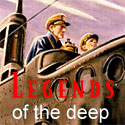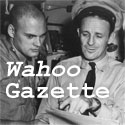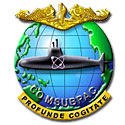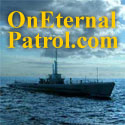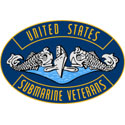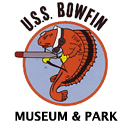With the official events concluded, Jeff and I still had a day to kill before our flights departed Friday evening. This was the impetus for our request to Admiral Walsh for a base tour. Originally, Admiral Walsh upped the ante and told us he would get us on a submarine. However, on Friday we were to learn this was not possible. In any event, the possibility of getting on the submarine base was an enormous thrill for me. Bryan Mackinnon and I were talking right before Jeff approached the Admiral and also heard the conversation. Naturally, he was onboard for the event as well.
On Friday morning we heard from our contact, Rowena, that we were to be at the base at 2:30. Jeff and I hooked up with Bryan after lunch at the Hale Koa Hotel following a long misadventure with the public transportation system which I will NOT recount. We said our good-byes to George & Tom Logue and Ms. Saga and piled into Bryan's van.
We got to the base in no time thanks to GPS navigation and hooked up with Rowena, a civilian employee of the public affairs office. She drove us to the submarine memorial park on the base. We soon found ourselves climbing on the same fairwater upon which Captain Red Ramage won his Medal of Honor -- that of USS Parche.
 The park is lush and well maintained. Originally, it was to be the site of the memorial ceremonies but it was changed to the Bowfin due to the large turnout and inherent security complications. The wall of honor with plaques for each lost boat was very impressive. Perhaps it was the setting but this particular memorial has to be my personal favorite of all I have visited.
The park is lush and well maintained. Originally, it was to be the site of the memorial ceremonies but it was changed to the Bowfin due to the large turnout and inherent security complications. The wall of honor with plaques for each lost boat was very impressive. Perhaps it was the setting but this particular memorial has to be my personal favorite of all I have visited.
 Two seven bladed submarine screws were on display. I asked Rowena if she knew the type of boat from which they came but she was unsure. Our best guess was a Barbel class diesel boat.
Two seven bladed submarine screws were on display. I asked Rowena if she knew the type of boat from which they came but she was unsure. Our best guess was a Barbel class diesel boat.
 From there we went to Lockwood Hall. This imposing art deco structure predates the second world war and is the site of the bachelor officer's quarters.
From there we went to Lockwood Hall. This imposing art deco structure predates the second world war and is the site of the bachelor officer's quarters.
 The back patio is the location where Admiral Lockwood and his men would conduct "convoy college". Historians are interested in any photos which depict the floor as it was painted during the war. They wish to recreate it.
The back patio is the location where Admiral Lockwood and his men would conduct "convoy college". Historians are interested in any photos which depict the floor as it was painted during the war. They wish to recreate it.
 Today the building is used for conferences as well as relaxation. Rowena had made a presentation there earlier in the day. All the suites are named for famous boats. Access and use is arranged by pay grade. Rowena took us down a hall with brass plates naming all submarine force recipients of the Navy Cross. We ended up in a small room entitled "Skippers Lounge". A long wooden table was faced by a wall of photos of Navy Cross winners.
Today the building is used for conferences as well as relaxation. Rowena had made a presentation there earlier in the day. All the suites are named for famous boats. Access and use is arranged by pay grade. Rowena took us down a hall with brass plates naming all submarine force recipients of the Navy Cross. We ended up in a small room entitled "Skippers Lounge". A long wooden table was faced by a wall of photos of Navy Cross winners.
 Surprisingly, the image of Mush Morton was one I had not seen published before. Based on the other decorations he is wearing, my best guess is it was taken upon the presentation of his first award.
Surprisingly, the image of Mush Morton was one I had not seen published before. Based on the other decorations he is wearing, my best guess is it was taken upon the presentation of his first award.
 Behind the small wet bar hung a copy of the Petreshok print "Wahoo is Expendable" depicting Wahoo's final resting place. This artwork was featured in the Wahoo Gazette several years ago and I believe prints can still be obtained via the Wisconsin Maritime Museum (866-724-2356).
Behind the small wet bar hung a copy of the Petreshok print "Wahoo is Expendable" depicting Wahoo's final resting place. This artwork was featured in the Wahoo Gazette several years ago and I believe prints can still be obtained via the Wisconsin Maritime Museum (866-724-2356).
Rowena lead us through the opposite doors into the Clean Sweep lounge. This is a much larger room featuring a corner bar, big screen TV and another treasure trove of memorabilia on the wall. To my great pleasure we discovered a framed copy of an article I had written about Admiral Lockwood hanging with the other artifacts. Entitled "Charles Lockwood: Architect of Attack" the piece was commisioned by American Submariner magazine. What a privilege to have it hung in these hallowed halls!
 From there Rowena drove us towards the submarine escape tower. Along the way we stopped to view the base chapel and original base swimming pool. Both were built from funds raised by sub base personnel in the 1930's as government funding was not forthcoming.
From there Rowena drove us towards the submarine escape tower. Along the way we stopped to view the base chapel and original base swimming pool. Both were built from funds raised by sub base personnel in the 1930's as government funding was not forthcoming.
The chapel is a quaint white structure, simple in construction, with stained glass windows down each side. I loved the brass plaque beside the front door which boldly proclaimed above a cross that the building was dedicated "For the worship of God". Nothing ambiguous about that.
 The pool was a thrill for me because it figured prominently in the book that originally got me interested in Wahoo: "War Fish". Following Wahoo's first disappointing patrol, George Grider spent a lot of time swimming in the pool lcoated in front of the large, u-shaped enlisted barracks. There he met another officer who was an even better swimmer than himself. The man turned out to be Mush Morton.
The pool was a thrill for me because it figured prominently in the book that originally got me interested in Wahoo: "War Fish". Following Wahoo's first disappointing patrol, George Grider spent a lot of time swimming in the pool lcoated in front of the large, u-shaped enlisted barracks. There he met another officer who was an even better swimmer than himself. The man turned out to be Mush Morton.
 After snagging a few drinks from a vending machine we pulled up around the corner at the Submarine Escape Tower. This famous structure, constructed in the 1930's, is no longer used for training. Its upper level was converted into a meeting room in the 1980's and affords an incredible view of the base and surrounding harbor.
After snagging a few drinks from a vending machine we pulled up around the corner at the Submarine Escape Tower. This famous structure, constructed in the 1930's, is no longer used for training. Its upper level was converted into a meeting room in the 1980's and affords an incredible view of the base and surrounding harbor.

 We enlisted Bryan's kids in a quick round of the quiet game as we wouldn't know if it was in use until the elevator doors opened. If it was we were out of luck and would have to return to the ground floor. We held our breath and were rewarded with an empty room.
We enlisted Bryan's kids in a quick round of the quiet game as we wouldn't know if it was in use until the elevator doors opened. If it was we were out of luck and would have to return to the ground floor. We held our breath and were rewarded with an empty room.
The view was spectacular. We could see the several Los Angeles class submarines moored at the piers, and a grand view of the base. Once again, historic memorabilia on the walls detailed the training history of the strucure. Rowena made sure we didn't take photos of any restricted areas or objects and we dutifully complied.
 Back on ground level, we viewed the USS Greeneville tied up next to the parking lot, then moved across to the SubPac Administration Building behind the tower. This building also predates the war and housed the offices from which the Pacific submarine campaign was fought. Though it was closed, we could see several pictures taken aboard Wahoo on display in the lobby.
Back on ground level, we viewed the USS Greeneville tied up next to the parking lot, then moved across to the SubPac Administration Building behind the tower. This building also predates the war and housed the offices from which the Pacific submarine campaign was fought. Though it was closed, we could see several pictures taken aboard Wahoo on display in the lobby.
 An interesting note about the building was the second floor corner office we could see from the parking lot. Rowena identified it as the vantage point from which Admiral Husband Kimmel observed the destruction of Pearl Harbor on December 7, 1941.
An interesting note about the building was the second floor corner office we could see from the parking lot. Rowena identified it as the vantage point from which Admiral Husband Kimmel observed the destruction of Pearl Harbor on December 7, 1941.
 From there we wound our way back to the parking lot, passing the old storage buildings and machine shops, as well as the oldest remaining building on base. It dates back to the 1920's when Chester Nimitz originally established the base. Part of our route back took us down Morton Drive.
From there we wound our way back to the parking lot, passing the old storage buildings and machine shops, as well as the oldest remaining building on base. It dates back to the 1920's when Chester Nimitz originally established the base. Part of our route back took us down Morton Drive.
After thanking Rowena for her time and wonderful tour (her first as guide), Bryan dropped us off at Honolulu International Airport. From there Jeff and I made our way home that evening. As I winged my way back to Houston I ran through the events of the past week and tried to recall something I had longed to do or see which I hadn't been able to cross off my list. I couldn't come up with a single one.
Continue Reading
On Friday morning we heard from our contact, Rowena, that we were to be at the base at 2:30. Jeff and I hooked up with Bryan after lunch at the Hale Koa Hotel following a long misadventure with the public transportation system which I will NOT recount. We said our good-byes to George & Tom Logue and Ms. Saga and piled into Bryan's van.
We got to the base in no time thanks to GPS navigation and hooked up with Rowena, a civilian employee of the public affairs office. She drove us to the submarine memorial park on the base. We soon found ourselves climbing on the same fairwater upon which Captain Red Ramage won his Medal of Honor -- that of USS Parche.
 The park is lush and well maintained. Originally, it was to be the site of the memorial ceremonies but it was changed to the Bowfin due to the large turnout and inherent security complications. The wall of honor with plaques for each lost boat was very impressive. Perhaps it was the setting but this particular memorial has to be my personal favorite of all I have visited.
The park is lush and well maintained. Originally, it was to be the site of the memorial ceremonies but it was changed to the Bowfin due to the large turnout and inherent security complications. The wall of honor with plaques for each lost boat was very impressive. Perhaps it was the setting but this particular memorial has to be my personal favorite of all I have visited. Two seven bladed submarine screws were on display. I asked Rowena if she knew the type of boat from which they came but she was unsure. Our best guess was a Barbel class diesel boat.
Two seven bladed submarine screws were on display. I asked Rowena if she knew the type of boat from which they came but she was unsure. Our best guess was a Barbel class diesel boat. From there we went to Lockwood Hall. This imposing art deco structure predates the second world war and is the site of the bachelor officer's quarters.
From there we went to Lockwood Hall. This imposing art deco structure predates the second world war and is the site of the bachelor officer's quarters. The back patio is the location where Admiral Lockwood and his men would conduct "convoy college". Historians are interested in any photos which depict the floor as it was painted during the war. They wish to recreate it.
The back patio is the location where Admiral Lockwood and his men would conduct "convoy college". Historians are interested in any photos which depict the floor as it was painted during the war. They wish to recreate it. Today the building is used for conferences as well as relaxation. Rowena had made a presentation there earlier in the day. All the suites are named for famous boats. Access and use is arranged by pay grade. Rowena took us down a hall with brass plates naming all submarine force recipients of the Navy Cross. We ended up in a small room entitled "Skippers Lounge". A long wooden table was faced by a wall of photos of Navy Cross winners.
Today the building is used for conferences as well as relaxation. Rowena had made a presentation there earlier in the day. All the suites are named for famous boats. Access and use is arranged by pay grade. Rowena took us down a hall with brass plates naming all submarine force recipients of the Navy Cross. We ended up in a small room entitled "Skippers Lounge". A long wooden table was faced by a wall of photos of Navy Cross winners. Surprisingly, the image of Mush Morton was one I had not seen published before. Based on the other decorations he is wearing, my best guess is it was taken upon the presentation of his first award.
Surprisingly, the image of Mush Morton was one I had not seen published before. Based on the other decorations he is wearing, my best guess is it was taken upon the presentation of his first award. Behind the small wet bar hung a copy of the Petreshok print "Wahoo is Expendable" depicting Wahoo's final resting place. This artwork was featured in the Wahoo Gazette several years ago and I believe prints can still be obtained via the Wisconsin Maritime Museum (866-724-2356).
Behind the small wet bar hung a copy of the Petreshok print "Wahoo is Expendable" depicting Wahoo's final resting place. This artwork was featured in the Wahoo Gazette several years ago and I believe prints can still be obtained via the Wisconsin Maritime Museum (866-724-2356).Rowena lead us through the opposite doors into the Clean Sweep lounge. This is a much larger room featuring a corner bar, big screen TV and another treasure trove of memorabilia on the wall. To my great pleasure we discovered a framed copy of an article I had written about Admiral Lockwood hanging with the other artifacts. Entitled "Charles Lockwood: Architect of Attack" the piece was commisioned by American Submariner magazine. What a privilege to have it hung in these hallowed halls!
 From there Rowena drove us towards the submarine escape tower. Along the way we stopped to view the base chapel and original base swimming pool. Both were built from funds raised by sub base personnel in the 1930's as government funding was not forthcoming.
From there Rowena drove us towards the submarine escape tower. Along the way we stopped to view the base chapel and original base swimming pool. Both were built from funds raised by sub base personnel in the 1930's as government funding was not forthcoming.The chapel is a quaint white structure, simple in construction, with stained glass windows down each side. I loved the brass plaque beside the front door which boldly proclaimed above a cross that the building was dedicated "For the worship of God". Nothing ambiguous about that.
 The pool was a thrill for me because it figured prominently in the book that originally got me interested in Wahoo: "War Fish". Following Wahoo's first disappointing patrol, George Grider spent a lot of time swimming in the pool lcoated in front of the large, u-shaped enlisted barracks. There he met another officer who was an even better swimmer than himself. The man turned out to be Mush Morton.
The pool was a thrill for me because it figured prominently in the book that originally got me interested in Wahoo: "War Fish". Following Wahoo's first disappointing patrol, George Grider spent a lot of time swimming in the pool lcoated in front of the large, u-shaped enlisted barracks. There he met another officer who was an even better swimmer than himself. The man turned out to be Mush Morton. After snagging a few drinks from a vending machine we pulled up around the corner at the Submarine Escape Tower. This famous structure, constructed in the 1930's, is no longer used for training. Its upper level was converted into a meeting room in the 1980's and affords an incredible view of the base and surrounding harbor.
After snagging a few drinks from a vending machine we pulled up around the corner at the Submarine Escape Tower. This famous structure, constructed in the 1930's, is no longer used for training. Its upper level was converted into a meeting room in the 1980's and affords an incredible view of the base and surrounding harbor.
 We enlisted Bryan's kids in a quick round of the quiet game as we wouldn't know if it was in use until the elevator doors opened. If it was we were out of luck and would have to return to the ground floor. We held our breath and were rewarded with an empty room.
We enlisted Bryan's kids in a quick round of the quiet game as we wouldn't know if it was in use until the elevator doors opened. If it was we were out of luck and would have to return to the ground floor. We held our breath and were rewarded with an empty room.The view was spectacular. We could see the several Los Angeles class submarines moored at the piers, and a grand view of the base. Once again, historic memorabilia on the walls detailed the training history of the strucure. Rowena made sure we didn't take photos of any restricted areas or objects and we dutifully complied.
 Back on ground level, we viewed the USS Greeneville tied up next to the parking lot, then moved across to the SubPac Administration Building behind the tower. This building also predates the war and housed the offices from which the Pacific submarine campaign was fought. Though it was closed, we could see several pictures taken aboard Wahoo on display in the lobby.
Back on ground level, we viewed the USS Greeneville tied up next to the parking lot, then moved across to the SubPac Administration Building behind the tower. This building also predates the war and housed the offices from which the Pacific submarine campaign was fought. Though it was closed, we could see several pictures taken aboard Wahoo on display in the lobby. An interesting note about the building was the second floor corner office we could see from the parking lot. Rowena identified it as the vantage point from which Admiral Husband Kimmel observed the destruction of Pearl Harbor on December 7, 1941.
An interesting note about the building was the second floor corner office we could see from the parking lot. Rowena identified it as the vantage point from which Admiral Husband Kimmel observed the destruction of Pearl Harbor on December 7, 1941. From there we wound our way back to the parking lot, passing the old storage buildings and machine shops, as well as the oldest remaining building on base. It dates back to the 1920's when Chester Nimitz originally established the base. Part of our route back took us down Morton Drive.
From there we wound our way back to the parking lot, passing the old storage buildings and machine shops, as well as the oldest remaining building on base. It dates back to the 1920's when Chester Nimitz originally established the base. Part of our route back took us down Morton Drive.After thanking Rowena for her time and wonderful tour (her first as guide), Bryan dropped us off at Honolulu International Airport. From there Jeff and I made our way home that evening. As I winged my way back to Houston I ran through the events of the past week and tried to recall something I had longed to do or see which I hadn't been able to cross off my list. I couldn't come up with a single one.































